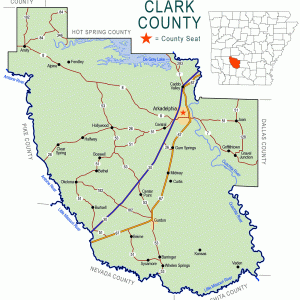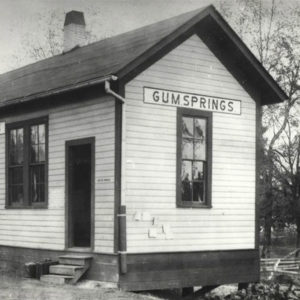calsfoundation@cals.org
Gum Springs (Clark County)
| Latitude and Longitude: | 34º04’02″N 093º05’31″W |
| Elevation: | 210 feet |
| Area: | 0.39 square miles (2020 Census) |
| Population: | 91 (2020 Census) |
| Incorporation Dates: | November 9, 1964 |
Historical Population as per the U.S. Census:
|
1810 |
1820 |
1830 |
1840 |
1850 |
1860 |
1870 |
1880 |
1890 |
1900 |
|
– |
– |
– |
– |
– |
– |
– |
– |
– |
– |
|
1910 |
1920 |
1930 |
1940 |
1950 |
1960 |
1970 |
1980 |
1990 |
2000 |
|
– |
– |
– |
– |
– |
– |
269 |
255 |
157 |
194 |
|
2010 |
2020 | ||||||||
|
120 |
91 |
Gum Springs is located five miles south-southwest of the Clark County seat of Arkadelphia. It is thought to have received its name due to a spring located near a gum tree on the original plot of land. In the mid-twentieth century, the town rose from a farming community to become an industrial center in Clark County. Today, Gum Springs has dwindled to a small rural town, as have many of the neighboring towns.
Little is known about the origins of the town, other than the fact that the Clark County poor farm was established near the eventual town site in 1887, and a post office was established in February 1889 under the direction of postmaster Henry Gerrell. In the early 1900s, the town—which was established along the Missouri Pacific railroad—was primarily a small agricultural community composed of farmers and sharecroppers. The white Baptist church burned in about 1925, never to be rebuilt. In 1922, the post office closed in favor of a rural mail carrier. Several years later, the train depot was closed. In 1949, the white school was consolidated with the Arkadelphia school system; the African-American school consolidated into Arkadelphia’s schools later.
For many years, the town was split by race. The west side of the town was primarily populated by African Americans, while whites occupied the eastern part. This changed in the early 1950s with the establishment of the Reynolds Aluminum Plant along the eastern side of the railroad in Gum Springs. This forced several families, primarily black families, to move their homes to other areas of the town. Shortly after the establishment of the plant, Gum Springs was incorporated, cementing the cooperation between the two sides of town under one central government.
The Reynolds plant began production of aluminum in February 1954 and continued aluminum production until its closure in June 1984. Combined with the 5,000-acre farm, also owned by the aluminum company, Reynolds Aluminum provided much of the employment and economic stability for residents of Gum Springs. The end of production at the plant ended much of the economic and population growth of the town.
In 1979, construction of the Clark County Industrial Park in Gum Springs provided a spark of hope for the town. However, the town has not seen a great deal of growth since the establishment of the industrial park. Today, the park houses the majority of the industry located in Clark County.
For additional information:
May, Joe. The Way We Were: A Pictorial History of Clark County. Hurst, TX: Curtis Media, 1995.
Richter, Wendy, ed. Clark County Arkansas: Past and Present. Arkadelphia, AR: Clark County Historical Association, 1992.
Syler, Allen, et al., eds. Through the Eyes of Farrar Newberry: Clark County, Arkansas. Arkadelphia, AR: Clark County Historical Association, 2002.
Jacob Worthan
Henderson State University
 Clark County Map
Clark County Map  Gum Springs Depot
Gum Springs Depot 




The consolidation in 1949 was only of the white schools. I attended 8th grade in the African-American school’s new location, after the move of the community and before Reynolds was operational. I don’t recall how many years passed before the black school was consolidated into Arkadelphia’s schools, but I know it was some time after the white school’s consolidation that the black Gum Springs school was discontinued and all the grades of children went to school in Arkadelphia. My father drove the school bus part of that time, after I was away in college.
I attended Peake High in Arkadelphia the next four years after Gum Springs Elementary, graduating in 1957. I moved on to what is now the University of Arkansas at Pine Bluff after that, and don’t recall the black Gum Springs school being consolidated before I moved away from Gum Springs after college; I graduated in 1961. I have pictures taken by my mother of Gum Springs Elementary school programs (Christmas programs, school closing program, etc.) that took place while I was in college, before any consolidation.